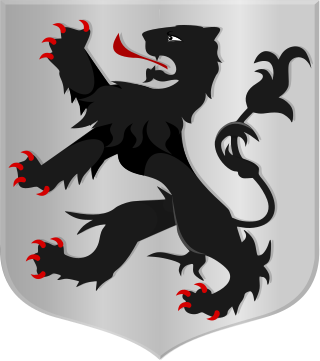
Maurice of Orange was stadtholder of all the provinces of the Dutch Republic except for Friesland from 1585 at the earliest until his death in 1625. Before he became Prince of Orange upon the death of his eldest half-brother Philip William in 1618, he was known as Maurice of Nassau.

Heeswijk Castle is a moated castle near Heeswijk in the Dutch province of North Brabant.

The Van Wassenaer family is the name of an old Dutch noble family. It was first mentioned in the County of Holland on 3 November 1200. They are one of the few original noble families from Holland that has survived to this day. Members of the family carry the title of count or baron.

Breda Castle is a castle in the city of Breda, in the Netherlands.

De Lek was a heerlijkheid (manor) and municipality in the Netherlands, located in the province South Holland. It is named after the Lek River.

Dirk III van Brederode was lord of Brederode.

Count John IV of Nassau-Siegen, German: Johann IV. Graf von Nassau-Siegen, official titles: Graf zu Nassau, Vianden und Diez, Herr zu Breda, was since 1442 Count of Nassau-Siegen, of Vianden and of half Diez, and Lord of Breda and of the Lek. He descended from the Ottonian Line of the House of Nassau.

Engelbert I of Nassau was a son of Count John I of Nassau-Siegen and Countess Margaret of the Mark, daughter of Count Adolph II of the Marck.

Lady Mary of Looz-Heinsberg, Dutch: Maria van Loon-Heinsberg, was a noble lady from the House of Looz and through marriage Countess of Nassau-Siegen.

Johanna van Polanen was a Dutch noblewoman. She was the daughter of John III of Polanen, Lord of Breda, and his wife, Odilia of Salm. The House of Polanen was a side branch of the still existing House of Wassenaer.

John III of Wassenaer, Lord of Polanen was Lord of Polanen. The Lords of Polanen were a branch of the House of Wassenaer. He held extensive possessions besides the fief of Polanen.

John II, Lord of Polanen was Lord of Polanen, Lord of De Lek and Lord of Breda.

Dorst is a village in the municipality Oosterhout, in the Dutch province North Brabant. Dorst is located near Rijen and the nearest cities are Breda, Oosterhout and Tilburg.

John I, Lord of Polanen was Lord of Polanen, and Lord of De Lek.

Willem van Duvenvoorde or van Duvoorde (1290–1353), also known as Willem Snikkerieme, was a 14th-century nobleman and financier who served as a financial and political adviser to four successive counts and countesses of Hainaut and Holland.

Willem IV of Horne (1303–1343) was Lord of Altena, Weert, Nederweert, Wessem, Heeze, Leende, and Cortessem. From his niece Beatrice of Leuven he inherited Gaasbeek, Leeuw, Herstal and Montcornet.

Polanen Castle was a castle located in today's Monster, South Holland in the Netherlands. The ancestral home of the Polanen family, it suffered a siege in 1351 and was demolished in 1394. It was replaced by a small manor somewhat to the south.
The Siege of Geertruidenberg (1351–1352) was a long siege of Geertruidenberg Castle during the first of the Hook and Cod wars.

Philips I, Lord of Polanen became Lord of Polanen in 1345. He later became Lord of Capelle, Nieuwerkerk, and Uyterlier. Philips was an important commander during the Hook and Cod wars.

Nassau Palace was the former city palace of the House of Orange in Brussels. The palace was constructed in the 14th century and expanded in the following centuries. In the 18th century, it was acquired by Governor of the Habsburg Netherlands, Prince Charles Alexander of Lorraine, who replaced it with the Palace of Charles of Lorraine. Today, nothing remains except the chapel, which is part of the building of the Royal Library of Belgium (KBR)
This page is based on this
Wikipedia article Text is available under the
CC BY-SA 4.0 license; additional terms may apply.
Images, videos and audio are available under their respective licenses.




















